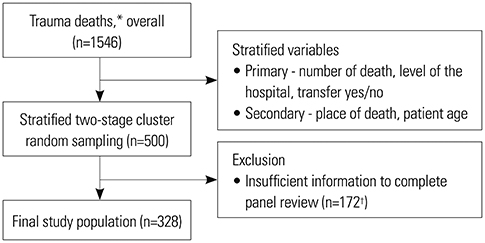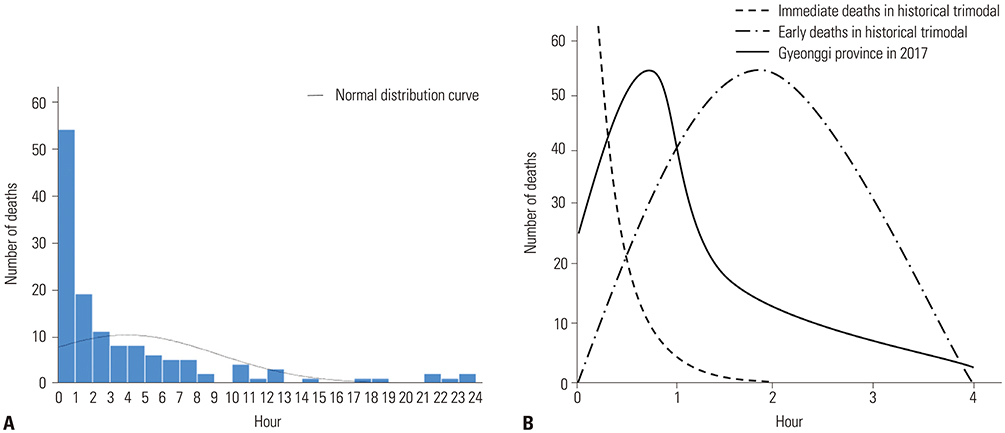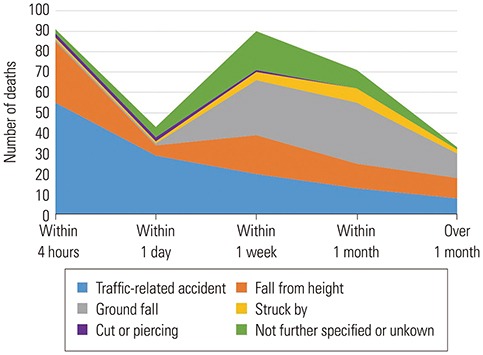Yonsei Med J.
2020 Mar;61(3):229-234. 10.3349/ymj.2020.61.3.229.
Distribution of Trauma Deaths in a Province of Korea: Is “Trimodal†Distribution Relevant Today?
- Affiliations
-
- 1Division of Trauma Surgery, Department of Surgery, Ajou University School of Medicine, Suwon, Korea. ermdhuhyo@gmail.com
- 2Ajou University Hospital/Gyeonggi South Regional Trauma Center, Suwon, Korea.
- 3Health Insurance Review & Assessment Research Institute, Wonju, Korea.
- KMID: 2470919
- DOI: http://doi.org/10.3349/ymj.2020.61.3.229
Abstract
- PURPOSE
This study was designed to provide a basis for building a master plan for a regional trauma system by analyzing the distribution of trauma deaths in the most populous province in Korea.
MATERIALS AND METHODS
We investigated the time distribution to death for trauma patients who died between January and December 2017. The time distribution to death was categorized into four groups (within a day, within a week, within a month, and over a month). Additionally, the distribution of deaths within 24 hours was further analyzed. We also reviewed the distribution of deaths according to the cause of death and mechanism of injury.
RESULTS
Of the 1546 trauma deaths, 328 cases were included in the final study population. Patients who died within a day were the most prevalent (40.9%). Of those who died within a day, the cases within an hour accounted for 40.3% of the highest proportion. The majority of trauma deaths within 4 hours were caused by traffic-related accidents (60.4%). The deaths caused by bleeding and central nervous system injuries accounted for most (70.1%) of the early deaths, whereas multi-organ dysfunction syndrome/sepsis had the highest ratio (69.7%) in the late deaths. Statistically significant differences were found in time distribution according to the mechanism of injury and cause of death (p<0.001).
CONCLUSION
The distribution of overall timing of death was shown to follow a bimodal pattern rather than a trimodal model in Korea. Based on our findings, a suitable and modified trauma system must be developed.
Keyword
Figure
Reference
-
1. Trunkey DD. Trauma. Accidental and intentional injuries account for more years of life lost in the U.S. than cancer and heart disease. Among the prescribed remedies are improved preventive efforts, speedier surgery and further research. Sci Am. 1983; 249:28–35.2. Demetriades D, Murray J, Charalambides K, Alo K, Velmahos G, Rhee P, et al. Trauma fatalities: time and location of hospital deaths. J Am Coll Surg. 2004; 198:20–26.3. Demetriades D, Kimbrell B, Salim A, Velmahos G, Rhee P, Preston C, et al. Trauma deaths in a mature urban trauma system: is “trimodal” distribution a valid concept? J Am Coll Surg. 2005; 201:343–348.
Article4. Pang JM, Civil I, Ng A, Adams D, Koelmeyer T. Is the trimodal pattern of death after trauma a dated concept in the 21st century? Trauma deaths in Auckland 2004. Injury. 2008; 39:102–106.
Article5. Gunst M, Ghaemmaghami V, Gruszecki A, Urban J, Frankel H, Shafi S. Changing epidemiology of trauma deaths leads to a bimodal distribution. Proc (Bayl Univ Med Cent). 2010; 23:349–354.
Article6. Jung KY, Kim JS, Kim Y. Problems in trauma care and preventable deaths. J Korean Soc Emerg Med. 2001; 12:45–56.7. Kim Y, Jung KY, Cho KH, Kim H, Ahn HC, Oh SH, et al. Preventable trauma deaths rates and management errors in emergency medical system in Korea. J Korean Soc Emerg Med. 2006; 17:385–394.8. Kim H, Jung KY, Kim SP, Kim SH, Noh H, Jang HY, et al. Changes in preventable death rates and traumatic care systems in Korea. J Korean Soc Emerg Med. 2012; 23:189–197.9. Moon S, Lee SH, Ryoo HW, Kim JK, Ahn JY, Kim SJ, et al. Preventable trauma death rate in Daegu, South Korea. Clin Exp Emerg Med. 2015; 2:236–243.
Article10. Jung K, Kim I, Park SK, Cho H, Park CY, Yun JH, et al. Preventable trauma death rate after establishing a national trauma system in Korea. J Korean Med Sci. 2019; 34:e65.
Article11. World Health Organization. Guidelines for trauma quality improvement programmes. Geneva: WHO Press;2009.12. Na JY, Park JP, Park HJ, Lee BW, Choi YS, Seo JS. The statistical analysis on legal autopsy performed in Korea during 2012 year. Korean J Leg Med. 2013; 37:198–207.
Article13. Lee KH. Current status and future perspective of regional trauma center in Korea. J Korean Med Assoc. 2016; 59:917–918.
Article14. Yoon HD. Background and progress of regional trauma center development. J Korean Med Assoc. 2016; 59:919–922.
Article15. Lim H, Chang WJ, Kim SH. Distribution of time to death in trauma patients: a review of 11 years' experience at a tertiary care teaching hospital. J Korean Soc Emerg Med. 2001; 12:457–466.16. Cothren CC, Moore EE, Hedegaard HB, Meng K. Epidemiology of urban trauma deaths: a comprehensive reassessment 10 years later. World J Surg. 2007; 31:1507–1511.
Article17. Shafi S, Renfro LA, Barnes S, Rayan N, Gentilello LM, Fleming N, et al. Chronic consequences of acute injuries: worse survival after discharge. J Trauma Acute Care Surg. 2012; 73:699–703.18. Trunkey DD, Lim RC. Analysis of 425 consecutive trauma fatalities: an autopsy study. J Am Coll of Emerg Phys. 1974; 3:368–371.
Article19. Baker CC, Oppenheimer L, Stephens B, Lewis FR, Trunkey DD. Epidemiology of trauma deaths. Am J Surg. 1980; 140:144–150.
Article20. Shackford SR, Mackersie RC, Holbrook TL, Davis JW, Hollingsworth-Fridlund P, Hoyt DB, et al. The epidemiology of traumatic death. A population-based analysis. Arch Surg. 1993; 128:571–575.21. Sauaia A, Moore FA, Moore EE, Moser KS, Brennan R, Read RA, et al. Epidemiology of trauma deaths: a reassessment. J Trauma. 1995; 38:185–193.22. Meislin H, Criss EA, Judkins D, Berger R, Conroy C, Parks B, et al. Fatal trauma: the modal distribution of time to death is a function of patient demographics and regional resources. J Trauma. 1997; 43:433–440.23. Sobrino J, Shafi S. Timing and causes of death after injuries. Proc (Bayl Univ Med Cent). 2013; 26:120–123.
Article24. Mullins RJ, Mann NC, Hedges JR, Worrall W, Helfand M, Zechnich AD, et al. Adequacy of hospital discharge status as a measure of outcome among injured patients. JAMA. 1998; 279:1727–1731.
Article25. Probst C, Zelle BA, Sittaro NA, Lohse R, Krettek C, Pape HC. Late death after multiple severe trauma: when does it occur and what are the causes? J Trauma. 2009; 66:1212–1217.
Article26. Claridge JA, Leukhardt WH, Golob JF, McCoy AM, Malangoni MA. Moving beyond traditional measurement of mortality after injury: evaluation of risks for late death. J Am Coll Surg. 2010; 210:788–794.
Article
- Full Text Links
- Actions
-
Cited
- CITED
-
- Close
- Share
- Similar articles
-
- A Study on Tuberculosis Mortality Rate in Seoul and Kyong gi Province, 1968
- The Effects of Chest Injury in the Early Deaths of Trauma Patients
- The Distribution of Time to Death in Trauma Patients
- A Statistical Observation of Unusual Deaths in Cheju, 1977 : An Analysis of Medico-Legal Autopsy and Inspection Cases
- A Statistical Analysis of Forensic Autopsies Performed in the Jungbu Province of Korea in 2020





